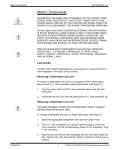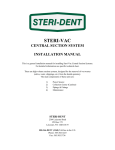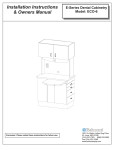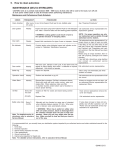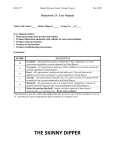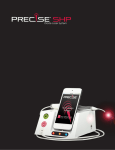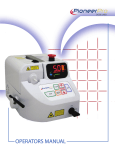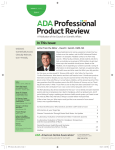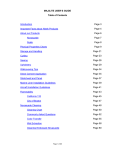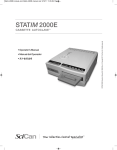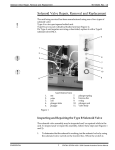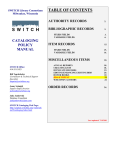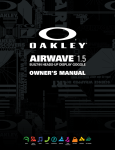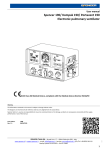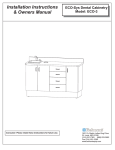Download Operatory Maintenance
Transcript
ChairSide Essentials For more than 100 years, your most OFFICE MAINTENANCE - OPERATORIES Maintaining the Dental Operatory: Items To Consider In Operatory Maintenance: Within the operatory, there are some common items that routinely pop up as problems resulting in a service call: air/water syringes leaking and buttons sticking, vacuum valves that get tight and seem to lose their vacuum power, tubings and upholstery get dry, hard, cracked and stained. These lead to air and vacuum leaks as well as a dirty looking operatory environment, water clogs in syringe tips, handpieces and control blocks. Also the water gets musty smelling like a wet basement. These common issues can be drastically reduced by understanding the causes and utilizing a little routine maintenance. Fig. C Fig. B Fig. A New Button Kit Ref. # 1 2 3 4 5 6 6 7 A-dec S/E Valve Parts List Description O-ring - S/E tip holder S/E valve Autoclavable O-ring - for S/E Rotor S/E Rotor Cartridge w/ o-rings S/E Tailpiece Autoclavable Tip Holder S/E Black Tip Holder S/E Gray S/E Screen Part # 034-107-00 12-1089-00 034-012-00 12-1093-00 12-1088-00 12-0183-00 12-0183-01 12-0180-00 7 16 Ref. # 1 2 3 4 5 7 A-dec HVE Valve Parts List Description O-ring - HVE Tip Holder O-ring - HVE Rotor HVE, Autocl Rotor w/ O-rings Screen, Spring Clip for QD HVE Tailpiece, QD, Short Surf color Tailpiece, QD, Short Grey color HVE Valve long, Autocl complete Part # 034-013-01 034-014-01 11-1074-00 11-0998-00 11-1027-00 11-0989-00 11-1177-00 trusted source for dental supplies and equipment. Winter 2009 Edition Assistant’s Instrumentation Maintenance Air/Water Syringe Common Issues: Vacuum Valves – HVE and Saliva Ejector Common Problems: 1. Valves tight and hard to open and close. 2. Suction is low or weak To prevent these problems: 1. Most HVE valves have QD connections allowing them to be removed and ultrasonically cleaned routinely. Lack of regular cleaning and lubrication will allow debris to work into the rotor and damage it so that it can’t be lubed enough to return to a like new condition. 2. Keep extra o-rings on hand and replace them semi-annually to keep the valve operating smoothly. Always lubricate the o-rings with silicone lubricant prior to reassembling the valve. 3. Build-up in lines can lead to weak suction. As the suction is used, lines can develop a crust on the inside walls that make the lines smaller. This can cause large debris to hang up and create clogs. Lines should at a minimum have a quart of warm water run through them each day. Then weekly, run a quart of non-foaming cleanser through each operatory. To do this, utilize a non-foaming enzymatic solution mixed in an atomizer jug that is designed specifically for vacuum line cleaning. These jugs allow air to mix with the solution creating a scrubbing effect in the lines. The Vacusol Ultra atomizer allows the assistant to hook up the lines and walk away. A metered dose of exactly a quart will be pulled into the lines. One mixture will do 3 rooms. If you do not have an atomizer, make sure that you do not pull straight liquid through the lines as it will not clean the lines well and can cause problems with your vacuum. Always allow air to enter with the cleaner. 4. The solids collector on the unit should be checked weekly and cleaned or replaced as necessary. The main trap at the actual vacuum pump needs to be checked regularly. When running cleaner through your lines, large amounts of debris can break loose and fill this trap causing the suction to shut down. By keeping the disposable Evac-u-traps on hand, you will always have extra clean traps to swap out quickly in this situation. 17 OFFICE MAINTENANCE - OPERATORIES 1. Leaking out of end of the tip: (Figure A)This is caused by the buttons sticking and not sealing correctly. Common reasons this happens: A. Minerals in hard water can create mineral deposits around the o-rings in the syringe buttons causing them to stick and not seal properly. B. Bio-burden debris build-up from utilizing syringes without a barrier over them. As the doctor, hygienist or assistant works in the oral environment, saliva, blood and mucous get on the gloves. Then when using the syringe, this material can work into the o-rings in the buttons. This can lead to o-ring failure and a less than desirable situation for the patient. C. Disinfectant build-up. At the end of each procedure, most offices spray and wipe the syringe with a disinfectant liquid. This also works its way into the buttons and leaves an increasing layer of debris that can cause the o-rings to become stiff and not seal correctly. 2. Water leaking and dripping from around the nut or tip retainer. (Figure B) A. O-ring is torn and needs replacing. There is a small o-ring at the back end of this nut that the tip slides in and out of all day. Through repeated use, this o-ring can become torn and needs replacing. These o-rings can be purchased in a 10-pack and should be available for replacement whenever this situation occurs. To prevent these problems: 1. Air/water syringes should be covered with a barrier during use. While this can be difficult to get used to, it is the only way to prevent bio-burden from working into the buttons. 2. Syringes should be wiped down thoroughly with a disinfectant between patients. 3. Weekly - syringes should be wiped down with a mild soapy water solution and lubed with a silicone lubricant. (See general operatory surface cleaning guidelines on page 13.) 4. Spare parts for syringes should be kept in a maintenance kit in the office. A. O-rings for tip retainer nut. B. Spare button kits for your brand of syringe. C. Silicone lubricant. ChairSide Essentials For more than 100 years, your most Office Maintenance: OFFICE MAINTENANCE - OPERATORIES Handpiece Controls & Operatory Surfaces Within the operatory the need for disinfection is critical. With handpiece aerosols, saliva, blood and other infectious debris accumulating on instruments and surfaces, thorough cleaning and disinfecting is essential to prevent the spread of germs and disease to staff as well as other patients. There are several chemicals that are used for disinfecting dental equipment. Dental equipment manufacturers take this into account when choosing materials used in the manufacturing of their equipment items. However, to date, there has not been a material discovered that will stand up to all chemicals; and all surfaces exposed to disinfecting chemicals need to be thoroughly and regularly cleaned. For this reason, you will find in most user manuals of major equipment manufacturers the recommendation of barrier protection as their only approved means of eliminating cross contamination on touch and transfer surfaces. That is why it is important to consult your user manual for the equipment items you purchase and find materials that meet the manufacturer’s guidelines. In the day to day world of dental offices however, disinfectants are used regularly on these surfaces. In order for disinfectants to work, they must be in contact with the surface when it is clean. Therefore, most disinfectants serve as a cleaner and disinfectant. In order to have a clean surface, however, the dirty surface should be sprayed and then wiped clean. Then a layer of disinfectant is sprayed on the clean surface and allowed to air dry. The residue left behind stays in contact with any left behind germs and if contact is maintained for the required time as specified by the manufacturer, germs will be killed. This spray - wipe - spray technique is recommended by CDC. This residual layer of disinfectant will continue to build up over time and needs to be cleaned off. If not, this residue will dry vinyl and plastic surfaces and cause them to stain and crack. Nashville Dental cannot give you advice contrary to what our manufacturing partners recommend. So we DO NOT recommend use of disinfectants on surfaces that can be barrier protected. However, since so many offices feel the need to disinfect these surfaces, in this section we will discuss the different surfaces and how to best clean and maintain them so that they don’t prematurely wear and become irreparably stained and damaged. 18 trusted source for dental supplies and equipment. Winter 2009 Edition Chair & Stool Upholstery: Upholstery is designed for esthetics, comfort and durability. However, upholstery that is not maintained will soon become stained, dry and begin to crack. This can be avoided by following a regular routine for maintaining this surface. Many offices routinely disinfect this surface between patients. This exposes the material to these harsh compounds over and over again. If the office feels this is necessary, it is important to use a disinfectant with very low alcohol content and to avoid phenols. A few that are the gentlest on chair upholstery seem to be, Birex by Biotrol, Optim 33 by SciCan, ProSpray by Certol. There are others, but these have performed well. However, they ARE NOT recommended by the equipment manufacturers. If you are disinfecting your chairs, you need to clean them at least weekly. This will remove the disinfectant residue and help to prevent staining, drying and cracking. Palco manufactures a product for cleaning and conditioning chairs called TopCat Vinyl Maintenance Kit. The kit comes with a stain remover, cleaner and conditioner and a caddy for keeping the cleaners organized. Touch & Transfer Surfaces Lights, Tubings, X-rays, Countertops, Handpiece Controls, etc.: Many of these surfaces may be barrier protected. However, many offices disinfect these surfaces even if they have been covered during procedures. Just like the chairs, the materials used in manufacturing many of these surfaces are durable high quality polymers designed to stand up to the harsh operatory environment. However, if these are not cleaned properly and routinely, they too will become stained, hard, dry and cracked. Protocol for disinfecting these areas: 1. When cleaning and wiping tubings, hold the tubing with the end hanging down, then wipe down toward the end. This will help to eliminate tubings being pulled away from their connectors. 2. Wipe surfaces clean with a saturated 4x4 or towelette, then wipe again with a fresh saturated towelette. 3. Spraying control heads and areas with air and electric switches can lead to switch malfunctions. If possible, spray a 4x4 or towelette first and then wipe down these areas. 4. Weekly clean these areas to remove the disinfectant residue. General Operatory Surface Cleaning: Because these surfaces repeatedly are layered with disinfecting residue, it is important to routinely clean this residue off. Daily: 1. Mix a solution of warm water & a mild dish detergent like Palmolive or Joy Liquid in a bucket. 2. Dampen a sponge or cloth with the soapy solution and thoroughly wipe down all surfaces that have been disinfected throughout the week. This includes, chair surfaces, countertops, light handles, handpiece hangers and tubings. (Note: Turn off units using fiber optics so the bulbs are not on while wiping down these tubings.) 3. Use another cloth or sponge dampened with warm water to remove the residual soapy solution. 4. Dry. 3545 Topcat Vinyl Mntc Kit $49.89 Weekly: 1. Some manufacturers (e.g. Pelton & Crane) recommend using a household furniture wax like lemon Pledge, to restore the luster to your upholstery. (Note: Not all manufacturers recommend this. Refer to your user manual for details.) 2. Use a vinyl conditioner like the Topcat product listed above. 19 OFFICE MAINTENANCE - OPERATORIES NOTE: Chair upholstery is not considered, by the CDC guidelines, to be a cross contamination surface. Therefore, disinfection is only necessary when the upholstery becomes visibly soiled. For more than 100 years, your most CERTOL INFECTION CONTROL PROMOTIONS ChairSide Essentials Ea. $17.99 Ea. $42.19 Ea. $23.09 20 ChairSide Essentials For more than 100 years, your most S i m p l e Wa t e r l i n e M a i n t e n a n c e A -D E C IC X New A-dec ICX™ offers you a unique and effective way to maintain clean dental unit waterlines. First of all, it’s incredibly easy to use. Simply add one ICX tablet to an empty self-contained water bottle before each filling. As the effervescent tablet dissolves, ingredients are released into the water to help prevent contamination and the buildup of deposits. Measuring and mixing are not required—the ICX tablet does the work for you.* And since ICX is not harmful to your team, your equipment, or your patients, you can have peace of mind knowing that your waterline maintenance protocol is not only easy and effective, but also safe. • Convenient single tablet dispensing packet • Continuously present; eliminates need to purge waterlines • Preventative; remains active in the water during periods of non-use lasting up to 2 weeks • Has no effect on dentin bonding • Odorless and has no taste ICX is available for both 0.7-liter and 2-liter bottles. *As with all waterline protocols, achieving quality results requires adherence to the manufacturer’s recommended process. For more information on ICX or other A-dec products, contact your Nashville Dental account representtative today. ©2004 A-dec Inc. All rights reserved. 22 trusted source for dental supplies and equipment. Winter 2009 Edition Waterline Maintenance: Clean Water systems are simply a means of introducing chemicals to your water supply to prevent the growth of bacteria in these lines. Due to the popularity of these units, a number of products have been introduced to the market for treating the water used in these systems. In order for these systems to truly deliver “Clean” water, they have to be maintained correctly. Waterline Maintenance Protocol 1. Initially shock the system overnight with Sterilex Ultra. This will kill all biofilm in the lines. 2. The following morning (or Monday if done before leaving for the weekend), all lines need to be flushed thoroughly without handpieces or air/water syringe tips installed. (note: if Kavo electric motors are installed on your unit, be sure to remove the four hole tubing from the back of the control box prior to purging water lines. Debris that breaks loose can clog the water solenoid in the control box and cause water problems with the handpiece) Often times lots of debris will purge from the lines at this point and can clog tips and handpieces if installed. (repeat this process EVERY 6 MONTHS.) 3. Daily add an ICX tablet or other water cleaner to the bottles when refilled. This prevents the redevelopment of biofilm, killing any microbes in the water. 4. Daily put an empty bottle on each unit and purge lines with air. This prevents lines from sitting stagnant and wet overnight. (If not daily, do this AT LEAST weekly.) 5. Weekly – Remove bottles and wash with soap and water. Then rinse thoroughly. Sterilex ULTRA may be used as a system shock treatment semiannually or as a routine treatment to be done weekly prior to leaving for the weekend. This will eliminate using water treatment tablets. This process needs to be repeated every 6-9 days (minimum) if no other daily water treatments are being used. 513P . . . . . . . . . . . . . . . . . . . . . . . . . . . . . . . . . . . . . . . . . . . . . . . . .$49.79 (20 packets per box, each packet makes 8oz of solution.) ICX is an effervescing tablet specially formulated to help prevent contamination and maintain clean water lines in dental units. ICX remains active overnight, over weekends and even over extended periods of non-use (lasting up to two weeks.) Purging water lines at night is not necessary. ICX is FDA approved, non-corrosive to dental unit components and safe for patients and staff. .7 Liter (50 tablets) - 90.1064.00 . . . . . . . . . . . . .33.59 2 Liter (50 tablets) - 90.1065.00 . . . . . . . . . . . . . .50.39 BlueTab is simple to use and effective at maintaining clean dental unit waterlines. Add an effervescing tablet each time the bottle is filled. One tablet treats 700-750ml of water. Effective for up to 28 days. Tasteless, odorless and has no effect on bonding. (50 tablets) - BT50 . . . . . . . . . . . . . . . . . . . . . . . . . .30.29 MicroCLEAR - Rowpar Cleans and disinfects dental unit waterlines. Prevents biofilm build-up when used as a continous treatment for self-contained systems. Dual Bottle Clean Water/Irrigation System - DCI Dual bottle system has a selector switch allowing you to switch from city water to bottle delivery of medicaments of your choice. Unit also has a flush feature allowing you to run only air through your lines to purge any liquid preventing biofilm build-up while away from the office. This system is also effective in treating water lines to prevent biofilm build-up while away from the office. This Sytem is also effective in treating water lines to prevent biofilm from growing. 8177 . . . . . . . . . . . . . . . . . . . . . . . . .$199.00 DUWL22P . . . . . . . . . . . . . . . .40.79 2 Gallons 23 OF F I C E MA IN T E N A N C E - WAT ER LIN ES Due to the effects of biofilm growth in flexible vinyl tubings, effective means of regularly cleaning water lines is strongly recommended by the CDC and ADA. We recommend having a clean water bottle system at each location that delivers water to the oral cavity. Having a “Clean” Water system doesn’t necessarily mean you have clean water flowing through your unit. It really means that you have a controlled delivery of the quality of water or solution that is delivered through your unit.







